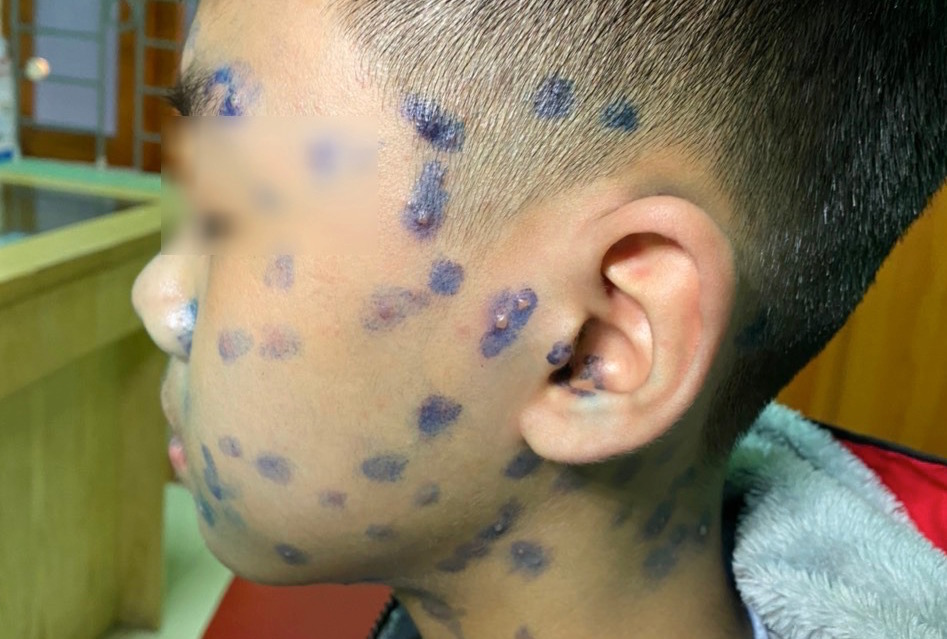The rash is full of people after being infected with Coronavirus, thinking that after Covid-19 has become an extremely contagious chickenpox disease
After contracting Covid-19, a 13-year-old boy developed a rash, small blisters all over his body, thinking that he was a post-Covid-19 symptom, but it was only when he did a molecular biology test that he knew he had this disease.
A 13-year-old child, after being infected with coronavirus, had a rash of tiny blisters scattered throughout the body, was treated at the local health facility in the direction of “viral rash” but his condition did not improve.
The baby was taken to Hung Vuong General Hospital (Phu Tho) by his family with the appearance of dense blisters, fever on the 3rd day, fatigue, joint pain, poor diet after being infected with coronavirus.
At Hung Vuong General Hospital, after clinical examination, the pediatric patient was diagnosed with Chickenpox and ordered to perform a molecular biology test by PCR method to determine the presence of Varicella-zoster virus (Varicella-zoster virus). VZV) is the virus that causes chickenpox. The test was positive for VZV virus.
Chickenpox is an infectious disease, caused by a virus, and often breaks out into an epidemic in the changing seasons, often in the spring. Although it is a benign disease, there is a possibility of blood infection complications leading to death.
 |
| The baby appeared rashes and tiny pimples all over his body after contracting Covid-19 |
Dr.BS Nguyen Van Lam – Head of the Department of Infectious Diseases, National Children’s Hospital, said that the virus that causes chickenpox is spread mainly through the respiratory tract (or the air), and healthy people are easily infected if they inhale the droplets. Foam is released when a person with chickenpox coughs, sneezes, or sneezes.
In addition, when coming into contact with a patient with chickenpox, the disease can be spread from blisters when broken, from damaged skin or sores from an infected person. In particular, pregnant women who are unfortunately infected will be very easy to transmit to the fetus through the placenta.
At onset, the patient may present with fever, headache, muscle pain, and in some cases, children may have no warning symptoms.
When infected with chickenpox, the patient’s body will appear “chicken bumps”. These are small round nodules that appear quickly within 12-24 hours, these nodules will evolve into blisters, blisters.
Nodules can grow all over the body or grow scattered on the body, the average number is about 100 – 500 nodules. Under normal circumstances these blisters dry up, become scabs and clear up on their own in 4-5 days.
In children, chickenpox usually lasts about 5 – 10 days leading to absences from school or daycare
TS.BS Nguyen Van Lam emphasized that chickenpox is usually a benign disease. But the disease can also cause dangerous complications such as meningitis, hemorrhage, sepsis, nodular infection, cellulitis, hepatitis … Some cases can be fatal if the patient is not treated. timely treatment.
Pneumonia caused by chickenpox, less common, is very severe and difficult to treat.
Encephalitis caused by chickenpox also occurs, not rare: after chickenpox, children suddenly become irritable, excited, sometimes accompanied by convulsions, coma. These cases may carry long-term neurological sequelae: deafness, retardation, epilepsy…
Mothers who contract chickenpox while pregnant can give birth to babies with birth defects later in life.
Because it is a respiratory disease and direct contact with blister fluid, when a child has chickenpox, the first thing parents should do is isolate the child at home until it is completely cured.
Add vitamin C, drop the nose 2 times a day for children.
Wear soft, sweat-wicking clothes and pay special attention to ensuring the baby’s skin hygiene to avoid complications.
Keep your child’s hands clean.
When you need to come into contact with someone with chickenpox, you must wear a mask. After contact, wash hands immediately with soap. Especially pregnant women should absolutely avoid contact with sick people.
Note: Avoid breaking the chickenpox nodules because it is easy to cause superinfection and can form long-lasting scars.
Located in a separate, well-ventilated room with sunlight, the isolation period is about 7 to 10 days from the onset of the disease (rash) until the blisters have completely dried up.
Use separate personal living items: towels, cups, cups, bowls, chopsticks.
Clean nose and throat daily with 0.9% physiological saline solution.
Change clothes and bathe daily with clean warm water.
Wear loose, light, thin clothing.
For children: it is recommended to trim the child’s nails, keep the child’s nails clean or use cloth gloves to cover the child’s hands to avoid complications of secondary skin infections caused by scratching and scratching the blisters.
Eat soft, liquid, easy-to-digest foods, drink plenty of water, especially fruit juices.
Use a solution of Milian blue (Methylene blue) to dab on broken blisters.
In case of high fever, common pain relievers can be used but must follow the doctor’s instructions, antibiotics can be used in case of infected sores: pus-filled sores, redness of the surrounding skin. .
If the patient feels: Irritability, lethargy, fatigue, convulsions, coma or bleeding on the chickenpox, they should immediately take them to medical facilities for monitoring and treatment.
This is a disease that can spread quickly in the community, but Dr. Dr. Nguyen Van Lam emphasized that there are now active measures to prevent chickenpox, which is vaccination with a vaccine.
For children from 12 months to 12 years of age, 1 dose should be given and the second dose should be given 6 weeks after the first dose or between 4-6 years of age to increase the effectiveness of prevention and reduce the risk of chickenpox. return despite previous vaccination. For children over 13 years of age, adolescents and adults, 2 doses are given, preferably 6 weeks apart.
N. Huyen
at Blogtuan.info – Source: infonet.vietnamnet.vn – Read the original article here


